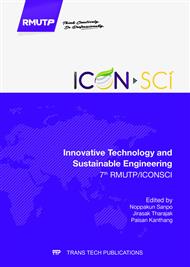[1]
P.H. Mayrhofer, H. Willmann, C. Mitterer, Oxidation kinetics of sputtered Cr–N hard coatings, Surf. Coat. Tech. 146-147(2001) 222–228.
DOI: 10.1016/s0257-8972(01)01471-2
Google Scholar
[2]
A. Kayani, T.L. Buchanan, M. Kopczyk, C. Collins, J. Lucas, K. Lund, R. Hutchison, P.E. Gannon, M.C. Deibert, R.J. Smith, D.S. Choi, V.I. Gorokhovsky, Oxidation resistance of mangetron-sputtered CrAlN coatings on 430 steel at 800 OC. Surf. Coat. Tech. 201(2006).
DOI: 10.1016/j.surfcoat.2006.08.049
Google Scholar
[3]
M. Uchida, N. Nihira, A. Mitsuo, K. Toyoda, K. Kubota, T. Aizawa, Friction and wear properties of CrAlN and CrVN films deposited cathodic arc ion plating method. Surf. Coat. Tech. 177-178(2004) 627-630.
DOI: 10.1016/s0257-8972(03)00937-x
Google Scholar
[4]
M. Brizuela, A. Garcia-Luis, J.I. Braceras, J. I. Onate, J. C. Sanchez-Lopez, D. Martınez-Martınez, C. Lopez-Cartes, A. Fernandez, Magnetron sputtering of Cr(Al)N coatings: Mechanical and tribological study. Surf. Coat. Tech. 200(2005) 195-197.
DOI: 10.1016/j.surfcoat.2005.02.105
Google Scholar
[5]
J. Lin, J.J. Moore, B. Mishra, M. Pinkas, W.D. Sproul, J.A. Rees, Effects of substrate bias frequencies on characteristics of chromium nitride coatings deposited by pulsed DC reactive magnetron spurrering. Surf. Coat. Tech. 2102(2008) 1418-1436.
DOI: 10.1016/j.surfcoat.2007.06.068
Google Scholar
[6]
Y.X. Wang, S. Zhang, J.W. Lee, W.S. Lew, B. Li, Influence of bias voltage on the hardness and toughness of CrAlN coatings via magnetron sputtering. Surf. Coat. Tech. 206(2012) 5103-5107.
DOI: 10.1016/j.surfcoat.2012.06.041
Google Scholar
[7]
S. Knamseh, M. Nose, T. Kawabata, A. Saiki, K. Matsuda, K. Terayama, S. Ikeno, Effect of deposition conditions on the structure and properties of CrAlN films prepared by pulsed DC reactive sputtering in FTS mode at high Al content. Materials Transactions. 49(2008).
DOI: 10.2320/matertrans.mra2008604
Google Scholar
[8]
J. C. Sánchez-López, A. Contreras, S. Domínguez-Meister, A. García-Luis, M. Brizuela, Tribological behaviour at high temperature of hard CrAlN coatings doped with Y or Zr. Thin Solid Films. 550(2014) 413–420.
DOI: 10.1016/j.tsf.2013.10.041
Google Scholar
[9]
L. Karlsson, L. Hultman, M.P. Johansson, J-E. Sundgren, H. Ljungcrantz, Growth, microstructure, and mechanical properties of arc evaporated TiCxN1-x (0 <= x <= 1) films. Surf. Coat. Tech. 126(2000) 1-14.
DOI: 10.1016/s0257-8972(00)00518-1
Google Scholar
[10]
Y. Chunyan, W. Shebin, T. Linhai, L. Tianbao, X. Bingshe, Microstructure and mechanical properties of CrAlN caotings deposited by modified ion beam enhanced magnetron sputtering on AISI H13 steel. J. Matter. Sci. 44(2009) 300-305.
DOI: 10.1016/j.apsusc.2008.10.089
Google Scholar


